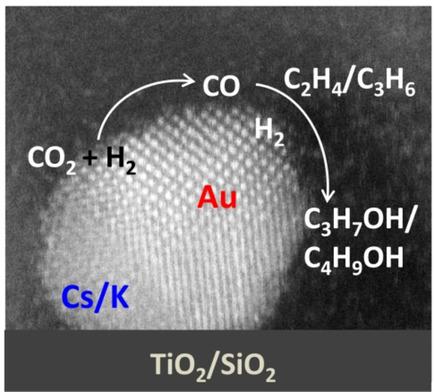当前位置:
X-MOL 学术
›
ChemSusChem
›
论文详情
Our official English website, www.x-mol.net, welcomes your
feedback! (Note: you will need to create a separate account there.)
Alcohol Synthesis from CO2, H2, and Olefins over Alkali‐Promoted Au Catalysts—A Catalytic and In situ FTIR Spectroscopic Study
ChemSusChem ( IF 7.5 ) Pub Date : 2018-12-14 , DOI: 10.1002/cssc.201801937 Denise Heyl 1 , Carsten Kreyenschulte 1 , Vita A. Kondratenko 1 , Ursula Bentrup 1 , Evgenii V. Kondratenko 1 , Angelika Brückner 1
ChemSusChem ( IF 7.5 ) Pub Date : 2018-12-14 , DOI: 10.1002/cssc.201801937 Denise Heyl 1 , Carsten Kreyenschulte 1 , Vita A. Kondratenko 1 , Ursula Bentrup 1 , Evgenii V. Kondratenko 1 , Angelika Brückner 1
Affiliation

|
Au/TiO2 and Au/SiO2 catalysts containing 2 wt % Au and different amounts of K or Cs were tested for alcohol synthesis from CO2, H2, and C2H4/C3H6. 1‐Propanol or 1‐butanol/isobutanol were obtained in the presence of C2H4 or C3H6. Higher yields of the corresponding alcohols were obtained over TiO2‐based catalysts in comparison with their SiO2‐based counterparts. This is caused by an enhanced ability of the TiO2‐based catalysts for CO2 activation, as concluded from in situ fourier‐transform infrared (FTIR) spectroscopy and temporal analysis of products (TAP) studies. The synthesized carbonate and formate species adsorbed on the support do not hamper CO2 conversion into CO and the hydroformylation reaction. The transformation of Auδ+ to active Au0 sites proceeds during an activation procedure. As reflected by CO adsorption and scanning transmission electron microscopy, the accessible Au0 sites are influenced by the amount of alkali dopants and the support. FTIR data and TAP tests reveal a very weak interaction of C2H4 with the catalyst, suggesting its quick reaction with CO and H2 after activation on Au0 sites to form propanol and propane.
中文翻译:

碱促进的金催化剂上由CO2,H2和烯烃合成醇的催化和原位FTIR光谱研究
测试了包含2 wt%的Au和不同量的K或Cs的Au / TiO 2和Au / SiO 2催化剂由CO 2,H 2和C 2 H 4 / C 3 H 6合成醇的能力。在C 2 H 4或C 3 H 6的存在下获得1-丙醇或1-丁醇/异丁醇。与基于SiO 2的对应物相比,在基于TiO 2的催化剂上获得了更高的相应醇收率。这是由于TiO 2基催化剂对CO 2的能力增强所致。如原位傅立叶变换红外(FTIR)光谱学和产品时间分析(TAP)研究得出的结论。吸附在载体上的合成碳酸盐和甲酸类物质不会阻碍CO 2转化为CO和加氢甲酰化反应。Auδ +向活性Au 0位点的转化在激活过程中进行。如通过CO吸附和扫描透射电子显微镜所反映的,可到达的Au 0位点受碱掺杂剂和载体的量影响。FTIR数据和TAP测试表明C 2 H 4与催化剂的相互作用非常弱,表明其与CO和H 2的快速反应在Au 0位上活化后形成丙醇和丙烷。
更新日期:2018-12-14
中文翻译:

碱促进的金催化剂上由CO2,H2和烯烃合成醇的催化和原位FTIR光谱研究
测试了包含2 wt%的Au和不同量的K或Cs的Au / TiO 2和Au / SiO 2催化剂由CO 2,H 2和C 2 H 4 / C 3 H 6合成醇的能力。在C 2 H 4或C 3 H 6的存在下获得1-丙醇或1-丁醇/异丁醇。与基于SiO 2的对应物相比,在基于TiO 2的催化剂上获得了更高的相应醇收率。这是由于TiO 2基催化剂对CO 2的能力增强所致。如原位傅立叶变换红外(FTIR)光谱学和产品时间分析(TAP)研究得出的结论。吸附在载体上的合成碳酸盐和甲酸类物质不会阻碍CO 2转化为CO和加氢甲酰化反应。Auδ +向活性Au 0位点的转化在激活过程中进行。如通过CO吸附和扫描透射电子显微镜所反映的,可到达的Au 0位点受碱掺杂剂和载体的量影响。FTIR数据和TAP测试表明C 2 H 4与催化剂的相互作用非常弱,表明其与CO和H 2的快速反应在Au 0位上活化后形成丙醇和丙烷。











































 京公网安备 11010802027423号
京公网安备 11010802027423号